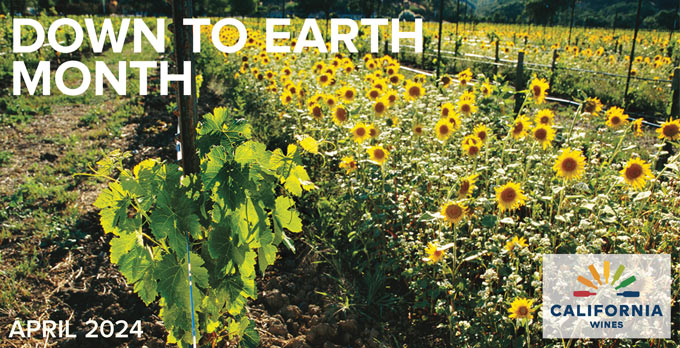
April 7, 2024 - SACRAMENTO — California Wines is launching its 13th annual Down to Earth Month celebrating the state’s global leadership in wine sustainability. Throughout April, the campaign highlights California’s commitment to sustainable viticulture and winemaking through environmental stewardship, economic impact, social equity and community engagement.
California — the world’s fourth-largest wine-producing region — has long been a global leader in sustainable winegrowing. Today, 80% of the state’s wine is produced in a certified-sustainable winery. By prioritizing sustainable practices, the state’s vintners and growers produce coveted wines while protecting our environment, being a good employer and neighbor, and ensuring vibrant family farms and businesses for generations to come. California wine producers are building a wine community where economic success, environmental stewardship and social responsibility thrive together.
To give consumers an inside look at the California wine community’s innovative sustainable practices, dozens of wineries and vintners’ associations across the state are hosting interactive events, activities and special offers — from eco-focused vineyard tours to wine tastings to festivals — all month long. For ongoing updates throughout April, visit DiscoverCaliforniaWines.com.
There are plenty of ways to celebrate and salute sustainability. Read on for tips on how to identify and enjoy sustainable wine and food during Down to Earth Month and beyond.
Look For The Logo
When purchasing wine, check the label for sustainability certifications. The vast majority of California wine is made by wineries certified under the California Sustainable Winegrowing Alliance (CSWA)’s Certified California Sustainable Winegrowing program, and many participating wineries display a “Certified California Sustainable” logo on their wine labels or on signs in their tasting room or winery.
Likewise, more than 60% of statewide winegrape acreage is certified under CSWA or to other California sustainability programs such as Fish Friendly Farming, LODI RULES, Napa Green and Sustainability in Practice (SIP). Each has its own seal for qualified wineries to include on their wine labels.
Before heading to the store, shoppers can also visit the California Sustainable Wine website to find certified wineries, wines and vineyards across the state, or check out winners of the California Green Medal Sustainable Winegrowing Leaderships Awardsannounced just this week:
- LangeTwins Family Winery and Vineyards — LEADER AWARD, given to the vineyard or winery that excels in the three “Es” of sustainability — Environmentally sound, socially Equitable and Economically viable practices.
- Gloria Ferrer — ENVIRONMENT AWARD, given to the vineyard or winery that best demonstrates Environmental Stewardship through maximized environmental benefits from implementing sustainable practices.
- Cooper-Garrod Vineyards at Garrod Farms — COMMUNITY AWARD, given to the vineyard or winery that is a Good Neighbor and Employer using the most innovative practices that enhance relations with employees, neighbors and/or communities.
- Vino Farms, LLC — BUSINESS AWARD, given to the vineyard or winery that best demonstrates Smart Business through efficiencies, cost savings and innovation from implementing sustainable practices.
Sustainability-minded consumers can take a similar approach when shopping for food. For example, look for signage or labels designating products as certified organic or certified regenerative.
Opt For Earth-Friendly — or Less — Packaging
While traditional glass bottles will always be a vessel for wine, California wineries have embraced a variety of packaging options to reduce their carbon footprints. High-quality wines can now be found in lightweight glass, bag-in-box packaging, pouches, cans and even paper bottles.
When shopping for produce at the grocery store, choose bulk items instead of pre-packaged foods and bring your own eco-friendly bags. Or, do your produce shopping at a local farmers market, bringing along your own reusable totes.
Choose Climate-Friendly Foods
Not all food is created equal when it comes to sustainability. Buying local is a simple way to reduce food’s carbon footprint because it minimizes transportation emissions.
Trading meat for more plant-based foods is another Earth-friendly option. Some of the most climate-friendly examples include fresh fruits and vegetables, mushrooms, whole grains and pulses such as beans, lentils and peas. Root vegetables require a small amount of water and growing space to produce, so potatoes, carrots and beets are all good bets. When buying nuts, opt for ground nuts or tree varieties such as pistachios, pecans and walnuts.
For meats, consider choosing lower-impact varieties such as poultry over beef or lamb. Environmentally friendly seafood options include farmed clams, oysters and mussels; responsibly farmed shrimp; Pacific cod; sustainably farmed and wild-caught salmon; and trout. For updates, see the Monterey Bay Aquarium Seafood Watch website at seafoodwatch.org.
About Wine Institute
Established in 1934, Wine Institute is the public policy advocacy group of more than 1,000 California wineries and affiliated businesses that initiates and advocates state, federal and international public policy to enhance the environment for the responsible production, consumption and enjoyment of wine. The organization works to protect the economic and environmental health of the state through its leadership in sustainable winegrowing and a partnership with Visit California to showcase California’s wine and food offerings and the state as a top travel destination. To learn more about California wines, visit Discover California Wines.
Source: Wine Institute
